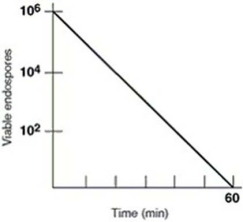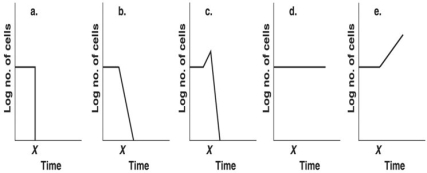A) oven at 121°C for one hour
B) bleach
C) pressure cooker at 121°C for 15 minutes
D) boiling for one hour
E) hydrogen peroxide
G) A) and C)
Correct Answer

verified
Correct Answer
verified
Multiple Choice
Which of the following results in lethal damage to nucleic acids?
A) heat
B) radiation
C) certain chemicals
D) heat and radiation
E) heat, radiation, and some chemicals
G) A) and C)
Correct Answer

verified
Correct Answer
verified
Multiple Choice
All of the following are effective for destroying prions EXCEPT
A) boiling.
B) NaOH + autoclaving at 134°C.
C) proteases.
D) incineration.
E) None of the answers are correct; each of these will destroy prions.
G) B) and E)
Correct Answer

verified
Correct Answer
verified
True/False
Desiccation is a reliable form of sterilization.
B) False
Correct Answer

verified
Correct Answer
verified
Multiple Choice
Which of the following is a limitation of the autoclave?
A) It cannot kill endospores.
B) It cannot inactivate viruses.
C) It cannot be used with glassware.
D) It cannot be used with heat-labile materials.
E) It requires an excessively long time to achieve sterilization.
G) A) and B)
Correct Answer

verified
Correct Answer
verified
Multiple Choice
Figure 7.1
 A suspension of 106 Bacillus cereus endospores was put in a hot-air oven at 170°C. Plate counts were used to determine the number of endospores surviving at the time intervals shown.
-In Figure 7.1, the decimal reduction time (D value) for the culture, which is defined as the time to reduce a population by one log, is approximately
A suspension of 106 Bacillus cereus endospores was put in a hot-air oven at 170°C. Plate counts were used to determine the number of endospores surviving at the time intervals shown.
-In Figure 7.1, the decimal reduction time (D value) for the culture, which is defined as the time to reduce a population by one log, is approximately
A) 40 minutes.
B) 30 minutes.
C) 0 minutes.
D) 10 minutes.
E) 60 minutes.
G) C) and D)
Correct Answer

verified
Correct Answer
verified
Multiple Choice
Figure 7.1
 A suspension of 106 Bacillus cereus endospores was put in a hot-air oven at 170°C. Plate counts were used to determine the number of endospores surviving at the time intervals shown.
-In Figure 7.1, what is the thermal death time?
A suspension of 106 Bacillus cereus endospores was put in a hot-air oven at 170°C. Plate counts were used to determine the number of endospores surviving at the time intervals shown.
-In Figure 7.1, what is the thermal death time?
A) 100°C
B) 120 minutes
C) 60 minutes
D) 150°C
E) The answer cannot be determined based on the information provided.
G) A) and B)
Correct Answer

verified
Correct Answer
verified
Multiple Choice
Which one of the following is most resistant to chemical biocides?
A) mycobacteria
B) protozoan cysts
C) gram-positive bacteria
D) gram-negative bacteria
E) viruses with lipid envelopes
G) A) and C)
Correct Answer

verified
Correct Answer
verified
Multiple Choice
Disinfection of water is achieved by all of the following EXCEPT
A) chlorine.
B) copper sulfate.
C) peracetic acid.
D) ozone.
E) UV radiation.
G) A) and C)
Correct Answer

verified
Correct Answer
verified
Multiple Choice
Which of the following treatments is the most effective for controlling microbial growth?
A) 140°C for 4 seconds
B) 63°C for 30 minutes
C) 72°C for 15 seconds
D) They are equivalent treatments.
E) None of the answers is correct.
G) A) and B)
Correct Answer

verified
Correct Answer
verified
Multiple Choice
Oxidizing agents include all of the following EXCEPT
A) iodine.
B) glutaraldehyde.
C) hydrogen peroxide.
D) chlorine.
E) ozone.
G) A) and D)
Correct Answer

verified
Correct Answer
verified
Multiple Choice
The preservation of beef jerky from microbial growth relies on which method of microbial control?
A) supercritical CO₂
B) filtration
C) desiccation
D) ionizing radiation
E) lyophilization
G) None of the above
Correct Answer

verified
Correct Answer
verified
Multiple Choice
Figure 7.2
Assume 109 E. coli cells/ml are in a flask.
 -Which graph in Figure 7.2 best depicts the effect of placing the culture in an autoclave for 15 minutes at time x?
-Which graph in Figure 7.2 best depicts the effect of placing the culture in an autoclave for 15 minutes at time x?
A) a
B) b
C) c
D) d
E) e
G) A) and B)
Correct Answer

verified
Correct Answer
verified
Multiple Choice
An iodophor is a(n)
A) iodine mixed with a surfactant.
B) agent that reduces oxygen.
C) quaternary ammonium compound.
D) form of formaldehyde.
E) phenol.
G) C) and E)
Correct Answer

verified
Correct Answer
verified
Multiple Choice
Figure 7.2
Assume 109 E. coli cells/ml are in a flask.
 -Which graph in Figure 7.2 best depicts the effect of placing the culture at 7°C at time x?
-Which graph in Figure 7.2 best depicts the effect of placing the culture at 7°C at time x?
A) a
B) b
C) c
D) d
E) e
G) D) and E)
Correct Answer

verified
Correct Answer
verified
Multiple Choice
Table 7.3 The following data were obtained by incubating gram -positive bacteria in nutrient medium + disinfectant for 24 hr, then transferring one loopful to nutrient medium (subculturing) . (+ = growth; - = no growth) -In Table 7.3, which disinfectant is the most effective at stopping bacterial growth?
A) Doom
B) K.O.
C) Mortum
D) Sterl
E) The answer cannot be determined based on the information provided.
G) B) and C)
Correct Answer

verified
Correct Answer
verified
Showing 41 - 56 of 56
Related Exams